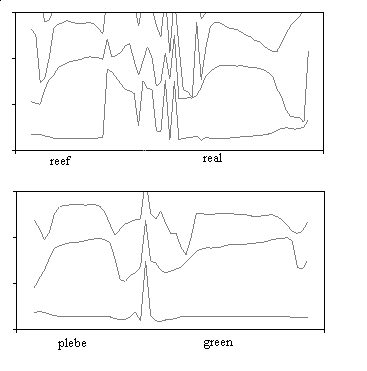|
|
|
alt-usage-english.org |
| Home |
| Newsgroup |
| Intro Documents A B C D E F G |
| FAQ |
| FAQ Supplement |
| ASCII IPA |
| Audio Archive |
| Links |
| UCLE Corner |
| What's New? |
| Search |
| Site Map Where am I? |
| Contact |
|
|
Showing variation of formants of [i:] with contextby Bob Cunningham
|
|
These plots were generated to evaluate an assertion that during the pronunciation
of [i:], the tongue moves front to back and then returns to its original position in
the front part of the mouth.
Note that in "reef", "plebe", and "green, the second formant rises in frequency during the pronunciation of the vowel. Greater separation of first and second formants corresponds to moving the tongue farther front. In contrast, the distance between the formants of "real" decreases slightly during the pronunciation of the vowel, because the frequency of F1 rises slightly. The rising F1 suggests that the tongue is moving slightly lower. None of the vowel's formants suggest that there is a noticeable backing then fronting of the tongue. The rise of F2 during the beginning of the vowel in "real" seems to correspond to the end of the pronunciation of "r"; the fall at the end, to the beginning of "l". The principal message carried by the plots is that it's hard to generalize about tongue motion during the pronunciation of a given vowel. A lot depends upon what the articulatory organs are doing before and after the vowel. The words were spoken by Bob Cunningham. |
|
